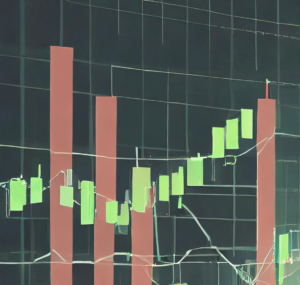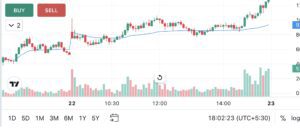VWAP Trading Strategy : Mastering Top 5 Intraday Trading

Introduction:
In the fast-paced world of intraday option trading, having a reliable strategy can make all the difference between success and frustration. One such strategy that has gained popularity among traders is the VWAP (Volume Weighted Average Price) strategy. In this comprehensive guide, we’ll delve into what VWAP is, how it works, and how you can use it effectively for intraday option trading.
What is VWAP?
VWAP stands for Volume Weighted Average Price. It’s more than just a technical indicator; it’s a window into the soul of the market, revealing the collective wisdom of traders’ actions throughout the trading day. At its core, VWAP calculates the average price a security has traded at, taking into account both price and volume. This weighted average provides a unique perspective, showing not only where the price has been but also where the market’s true sentiment lies.
How Does VWAP Work?
To calculate VWAP, you take the sum of the price multiplied by volume traded and divide it by the total volume traded over a specific time frame. This formula ensures that the VWAP considers both the price and volume of trades, giving more weight to higher volume trades.
For example, let’s say stock XYZ trades at the following prices and volumes throughout the day:
- 9:30 AM: Price = $100, Volume = 10,000 shares
- 10:00 AM: Price = $102, Volume = 15,000 shares
- 11:00 AM: Price = $101, Volume = 12,000 shares
To calculate VWAP at 11:00 AM, we would perform the following calculation:
VWAP=(100×10,000)+(102×15,000)+(101×12,000)10,000+15,000+12,000
VWAP=(1,000,000)+(1,530,000)+(1,212,000)37,000
VWAP=3,742,00037,000
VWAP = $101.135
This calculation yields a VWAP of $101.135 at 11:00 AM, indicating the average price at which XYZ has traded throughout the day weighted by volume.
Why Use VWAP Trading strategy for Option Trading?
VWAP is particularly useful for intraday option trading for several reasons:
- Benchmark for Traders: VWAP serves as a benchmark for traders to evaluate the fairness of their option prices relative to the broader market. By comparing option prices to VWAP, traders can assess whether they are getting a good deal or paying too much for their contracts.
- Identifying Market Trends: The VWAP line acts as a dynamic indicator of market sentiment, helping traders identify prevailing trends. When the option price is consistently above VWAP, it may signal bullish sentiment, while prices below VWAP may indicate bearish sentiment.
- Support and Resistance Levels: VWAP can act as dynamic support and resistance levels throughout the trading day. Traders often look for opportunities to buy near VWAP in an uptrend or sell short near VWAP in a downtrend.
- Confirmation Tool: VWAP can be used as a confirmation tool alongside other technical indicators to validate trading signals, enhancing the probability of successful trades.
Implementing the VWAP Trading Strategy for Intraday
Now, let’s explore how you can apply the VWAP strategy to intraday option trading:
1. Identifying Trade Setups:
Start by plotting the VWAP line on your intraday chart. Look for instances where the price of the option crosses above or below the VWAP line, signaling potential trade setups.
Example chart showing VWAP line and option price movement.
2. Confirming Entry Signals:
Once you’ve identified a potential trade setup, wait for confirmation signals such as a strong candlestick pattern or a surge in volume to validate your entry decision.
3. Setting Stop Loss and Target Levels:
Determine your stop-loss and target levels based on your risk tolerance and the prevailing market conditions. VWAP can help you set dynamic stop-loss levels as it moves throughout the trading day.
4. Managing Trade Execution:
Monitor the option’s price movement relative to VWAP and adjust your trade management accordingly. Consider scaling in or out of positions as the price interacts with VWAP.
5. Exiting Trades:
Exit your trades when the option price reaches your predefined target level or if the market conditions change unfavorably. VWAP can also act as a guide for determining optimal exit points.
Conclusion
In the high-stakes world of intraday option trading, having a reliable strategy can mean the difference between success and failure. The VWAP strategy offers traders a systematic approach to navigating the markets, leveraging the power of volume-weighted average prices to make informed trading decisions.
By understanding the mechanics of VWAP and mastering its application in intraday option trading, traders can gain a competitive edge in the market. However, like any trading strategy, success with VWAP requires discipline, patience, and proper risk management.
As you embark on your journey to master intraday option trading, remember that VWAP is just one tool in your arsenal. Continuously refine your skills, adapt to changing market conditions, and never stop learning. With dedication and perseverance, you can unlock the full potential of the VWAP strategy and achieve your trading goals in the dynamic world of intraday options.
Remember, like any trading strategy, VWAP is not foolproof and requires proper risk management and discipline. Practice implementing the VWAP strategy on a demo account or with small position sizes before committing real capital. With patience and perseverance, you can harness the power of VWAP to navigate the complexities of intraday option trading successfully.


